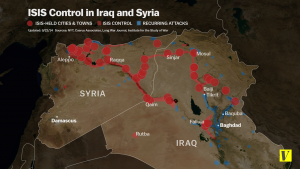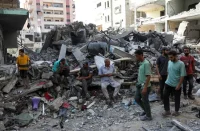(Please read Part I before this article)
The first part exposed the desperate push that the US is making into the heart of the Middle East from its new position of strategic weakness, while this section enumerates on the three primary ways that Russia and Syria can prevent this from happening. Iraq is excluded from this analysis because it’s outside the scope of Russian-Syrian operations, although it’s suggested that Baghdad coordinate with Tehran (its closest and most probable direct military partner) as soon as possible to stage its own Coalition of the Righteous (COR) offensive against the terrorists. It’s important that such an effort, whether it is eventually coordinated with the US or sabotaged by it, does not in any way result in a post-conflict “solution” that advances Washington’s plans for the Qatar-Turkey gas pipeline. Without further ado, here’s how Russia and Syria can crush ISIL and the US’ proxies once and for all in the Levant.
Look Before You Leap
Russia’s COR has the head start in the Race for Raqqa, and the on-the-ground momentum and force deployment numbers are clearly on their side. That said, however, the Syrian Arab Army (SAA) still has to break through the terrorists’ deep front lines that are separating the military from the ISIL ‘capital’, and it’s here where Russian airstrikes have been their most useful in changing the balance of power in favor of the government. The ongoing liberation offensives in Aleppo and Hama Governorates are positive indications of just how significantly the tide of war has changed in such a short period of time, and if the initiative continues, it’s likely that the SAA can sweep across the country all the way to Raqqa in record time.
In doing so, however, it needs to exercise wise judgement and not rush east just for the sake of doing so. It’s equally important to cut off the terrorists’ supply lines from Turkey and secure the liberated territories, which is what the military is actually doing at the moment. While liberating Raqqa is clearly a priority for the SAA, it’s just as much of a priority to make sure that the rear guard is not exposed to a surprise terrorist attack during the final push through the desert. A debilitating and disorienting strike from behind at the same time as the initiation of the Battle of Raqqa could lead to the strategically disadvantageous position of the SAA being caught in a pincer between two terrorist formations, or perhaps by that time, between the terrorists to their back and the “Democratic Forces of Syria” (DSF) to their front.
Although such a situation is not very probable owing to the information dominance that the COR has over Syria right now (with the Russian Aerospace Force’s drone and satellite intelligence playing a key role), if it did by unfortunate chance transpire, then the backstabbing terrorists would likely be wiped out in no time. At the worst, the only ‘success’ that this suicidal mission could ever hope to have would be to delay the SAA’s liberation offensive in Raqqa by a very short period of time, which, however, might cede some of the initiative to the “DSF” if they’re neck-and-neck in the ‘race’ by that time. The bigger issue, then, is whether or not the “DSF” will engage the SAA at any time during this campaign, and if they do, whether that would constitute them as a terrorist group that’s subject to Russian airstrikes. The last part of this article will actually describe that very scenario, including the possibility of the US drawing a firm red line in providing its proxies with air support, be it against ISIL or the SAA (if a post-Raqqa clash ensued).
The Deir ez-Zor And Hasakah Holdouts
What most of the Western mainstream media constantly fails to mention is that the SAA has consistently maintained a presence in the far northeastern cities of Deir ez-Zor and Hasakah ever since the conflict first erupted. These forces have repeatedly succeeded in securing their positions in both cities against ISIL’s advances, and they’ve been greatly aided by the control that they exercise over the positions, and as it relates to this article, also creates a major complication for the US’ plans in the area.
In the sense of disrupting the new US strategy in northeast Syria, the SAA units in Deir ez-Zor and Hasakah could converge on Raqqa concurrently with their comrades from the west and literally encircle the city, but provided that they have the means to do so. If these don’t presently exist (for example, if the troops are limited in numbers, equipment, and/or weapons), then Russia and the SAA could increase their supplies to the region in order to correct the imbalance and prepare these forces for partaking in the Battle of Raqqa. If for whatever reason Russian decision makers feel uncomfortable having their supply planes operate so deep into enemy territory and without any on-site Russian contingent to protect the landing zone, then they could opt instead to provide an air escort to their SAA counterpart that would carry out these responsibilities instead. No matter the form that it takes, there’s evidently a workable and mutually acceptable solution to accomplish this tactical goal.
On the other hand, the very presence of the SAA so far from the front lines and deep in the heart of northeast Syria, whether they engage in the upcoming decisive battle or not, is also an impediment to the US in and of itself. The de-facto independence (masqueraded as “autonomy”) that Washington wants to have its proxy-controlled areas granted would be dramatically weakened if the SAA maintains a force in the given territories, especially one that can realistically be expanded in the future. Therefore, although the US has given the “DSF” strict orders to refrain from engaging the SAA at the moment, it’s an inevitable certitude that ‘the rules’ will change in the immediate fallout of ISIL’s collapse in Raqqa (or right beforehand when such a development is incontrovertible). The US will then task its proxies or some of their members (the “Syrian Arab Coalition” more so than the YPG) with attacking the SAA positions in Deir ez-Zor and Hasakah, whether it officially acknowledges that it had ordered them to or simply blames it on “rogue moderate rebels”. No matter how the scenario unfolds, with Russia and the US providing air support for opposing ground forces, it creates the very real threat of a superpower confrontation between both of them in the very heart of the Mideast.
Bombs Away?
The US is operating from a position of strategic weakness, having been inflicted with such surprising setbacks over the past two weeks that its prior regional hegemony has all but crumbled under the weight of Russian anti-terrorist bombs. Still, as the saying goes, “a cornered fox is more dangerous than a jackal”, and the sly and cunning strategists in the US now feel pressed against the ultimate geopolitical wall. Their gambit in northeast Syria is the last possibility that they realistically have of retaining any on-the-ground influence whatsoever in the broad heartlands of the “Syraq” theater that they had previously controlled so confidently through their proxy forces. This means that the American strategic mentality must be understood as inherently unstable at the moment, so under certain circumstances, it could possibly ‘lash out’ in an ill-fated attempt to desperately protect its last remaining assets in the field.
 But, the US is not unstable to the point of being suicidal, so it’s not going to grandstand with such threats as having its proxies attack the SAA and intimate that it’ll provide air support for these operations (or even more dangerously, actually act on such a warning) unless there’s some relative position of strength that it has left to retain. In the context of this analysis, that would only occur in the event that the US’ proxies capture Raqqa before the SAA does, because solely in this strategic environment would it feel hopeful enough that it could succeed in clinging to the idea of an autonomous trans-border sectarian entity that would guarantee some vestige of influence retention. Without the capture of Raqqa, the US is predicted to completely abandon the Syrian theater and totally give up on its nearly five-year-long War on Syria, and despite any retreating rhetoric it spews about possibly supporting its on-the-ground proxies in the aftermath, it’s not expected to follow up on such ‘face-saving’ words at all.
But, the US is not unstable to the point of being suicidal, so it’s not going to grandstand with such threats as having its proxies attack the SAA and intimate that it’ll provide air support for these operations (or even more dangerously, actually act on such a warning) unless there’s some relative position of strength that it has left to retain. In the context of this analysis, that would only occur in the event that the US’ proxies capture Raqqa before the SAA does, because solely in this strategic environment would it feel hopeful enough that it could succeed in clinging to the idea of an autonomous trans-border sectarian entity that would guarantee some vestige of influence retention. Without the capture of Raqqa, the US is predicted to completely abandon the Syrian theater and totally give up on its nearly five-year-long War on Syria, and despite any retreating rhetoric it spews about possibly supporting its on-the-ground proxies in the aftermath, it’s not expected to follow up on such ‘face-saving’ words at all.
Should the pro-US forces succeed in capturing Raqqa, then that would considerably increase the likelihood that the northeast of Syria would try to press forward with the Brooking Institute’s federalization model, and that the “DSF” or their “Syrian Arab Coalition” member will turn on the SAA units in Deir ez-Zor and Hasakah and either demand their surrender/removal and/or forcefully attack them. This is the most dangerous scenario that can happen in Syria in the coming future, because it would then press the SAA to strike the US’ official proxies out of self-defense, which would immediately escalate the situation to the point of Washington issuing the predetermined anti-SAA bombing threats that were spoken about earlier.
Under such a tense state of affairs, Russia could not allow the US to bomb its decades-long ally (as it also demonstrated back in September 2013), especially after having succeeded together with it in eliminating most of the terrorists based in the country by that point, so Moscow and Washington would likely enter into a very suspenseful period of President-to-President negotiations in order to “deconflict” and preempt any unexpected clash between the two. After all, it would be complete pandemonium if the US started bombing the SAA while Russia responded by destroying the “DSF” and/or the “Syrian Arab Coalition”, because in the resultant chaos, unexpected exchanges might occur between both countries’ air forces that suddenly puts them on direct war footing against the other. It doesn’t seem as though either side has the appetite for such a confrontation, so a grand settlement a la the September 2013 one could likely be in the cards in that case.
It’s more probable that the SAA could at that time reach some sort of understanding with the Kurdish YPG than they could with the Arab and multinational mercenaries fighting under the “Syrian Arab Coalition” banner, thus opening the possibility for a final divide-and-rule offensive that guarantees the Kurds some sort of benefits in exchange for splitting ranks with their coalition partners and siding with Damascus. If this development could be made possible, then the fulcrum of the US’ proxy institutional support would collapse, and amidst the infighting, Russia, if it was feeling confident enough in its overall strategic position in the Mideast, could ‘call the US’ bluff’ and begin bombing the “Syrian Arab Coalition” members who refuse to surrender to the SAA and/or peacefully integrate into post-war society. It’s a gamble, of course, but it’s betting that the US won’t have the fortified will to go toe-to-toe with Russia over what amounts to a little less than barren (albeit super strategic) desert sand.
Concluding Thoughts
The US, fresh from licking its wounds and reluctantly accepting its junior status in the Mideast, is back for one last hurrah, albeit one of a much less geographic scope that before. That doesn’t make it any less dangerous, however, since its latest scheme is aimed at dividing the Coalition of the Righteous right down the middle and splintering Syria from Iraq via a faux “Sunni” sectarian “state” that runs between both of their borders. This semi-institutionalization of what amounts to literally the exact same thing that ISIL had been trying to build (albeit a non-genocidal entity in this latest iteration) would finally attain the long sought-after goal of realizing the Qatar-Turkey gas pipeline. The trans-border sub-state that the US wants to preserve and internationally recognize would directly abut Turkey and Saudi Arabia, thus establishing the perfect geo-energy corridor for its creation.
All of this hinges on who captures Raqqa, ISIL’s ‘capital’, first, and the race is now on between the Syrian Arab Army and the US’ newly assembled “Democratic Forces of Syria”. If the Syrian government succeeds in this enormously symbolic task, then there’s no doubt that the US will complete its retreat from the Mideast’s heartland with a whimper and its tail between its legs, but if the US’ proxies do it first, then the entire strategic balance is recalibrated, as they’d then evoke enough ‘facts on the ground’ to solidify their presence in the northeast of the country and move forward with the Brookings Institute’s plan for the post-war federalization of the country. Russia and Syria recognize the urgency involved, but at the same time, they’re exercising prudent judgement and responsible self-restraint in not blindly rushing towards Raqqa without first securing their rear guard from any potentially debilitating ambushes.
Even if the US’ proxy forces ‘beat them to the chase’, so to speak, Moscow and Damascus still have enough realistic options on the table to likely shift the dynamic back to their favor. This includes the SAA’s behind-enemy-lines deployments in Deir ez-Zor and Hasakah, as well as the government’s positive history of relations with the Kurds, both of which can effectively be used to divide the anti-government coalition and open the door for the final liberation offensive of the war. Nevertheless, both strategies might encounter significant friction, and with the US and Russia’s official on-the-ground counterparts preparing to finally fight one another in the most decisive battle that the War on Syria had hitherto experienced, the situation might immediately escalate beyond what anybody is expecting. The resultant crisis would surely become the most epic faceoff between Washington and Moscow since the dark days of October 1962, although this time, it’ll likely be the US that blinks first.
Hamsa Haddad, the Syrian researcher based in Moscow, contributed to this article.














Pingback: The Race For Raqqa And America’s Geopolitical Revenge In “Syraq” (I) | Oriental Review
The Kurds in Syria, indeed, are the difference. They hold the key with Syria and Turkey and are crucial on the battlefield.
What is interesting, Andrew, is the lack of mention almost of the impact of Iran in your outline of possible events.
Presently, Iran and the Quds force has not been felt inside Syria on the battlefield. Hezbollah has taken the brunt of the war in Iran’s behalf. Yet, Iran has as much to lose in all these scenarios as any nation.
I hope you can illuminate in a near-future article what you think Iran is doing and will do for and with Syria-Russia.
The other quiet player with much to lose if this war lingers another six months or a year more is Jordan. I’d like to read what you think is really going on with Jordan. The King was one of the players who went to Moscow before this Russian campaign began. Could Jordan be working both sides, a dependent ally of US, but a willing “silent partner” with Russia?